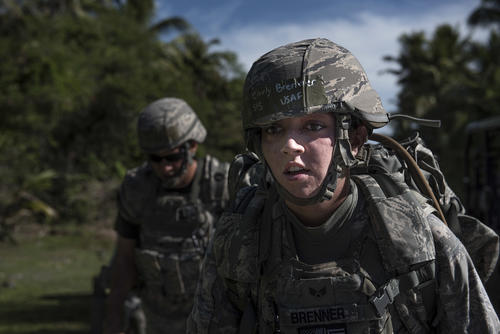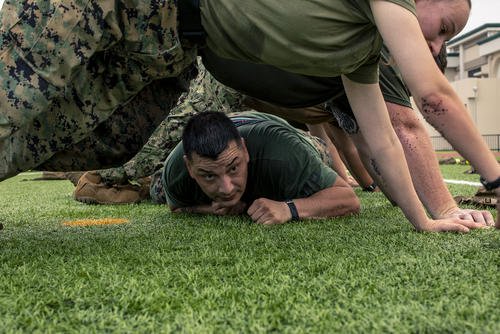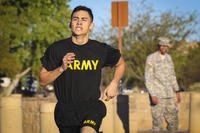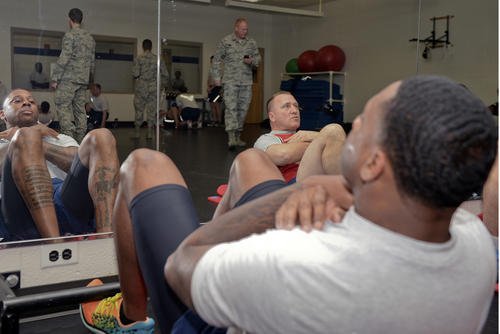Staying fit in tight spaces with little to no equipment is always a challenge, whether you are in a hotel room or living and working on a ship.
Tight quarters, limited equipment and unpredictable schedules may seem like obstacles, but with the right mindset and approach, you can stay in top shape anywhere. Facing fitness testing twice a year, both the Navy and Coast Guard often have these training dilemmas when on board their ships.
Military ships are not designed for fitness functionality, however. They are war machines with not much space for moving about. Some ships, though, have more space than others and even include cardio machines, weights and other fitness equipment. Smaller vessels have none.
Read Next: The Best Nutrition Tips Right Before a Military Fitness Test
Despite these constraints, the Navy fitness test, called the Physical Readiness Test, is still required twice a year for all sailors and officers. With some forethought, you can maintain or even build strength, endurance and flexibility while at sea. The good news is that the fitness test for the Navy consists of push-ups, a plank pose and a 1.5-mile run, or 500-meter swim.
Drawing from years of practice with calisthenics and cardio workouts with little to no equipment, here are a few practical and resourceful workout strategies for those at sea or in other similar environments.
Two-Thirds of the Test Can Be Practiced Anywhere
Body-weight exercises are the cornerstone of fitness testing in many of the military's branch fitness assessments.
Push-ups and planks require no equipment and can be performed almost anywhere and at the same time. Try the Death by Push-ups Challenge Workout for five to 10 minutes to master both exercises with limited time and space. Try the following upper- and lower-body circuits, and repeat each round multiple times, depending on your goals and ability level. Rest as needed between rounds:
Repeat 5-10 times.
- Push-ups: 15-20 reps
- Burpees: 10-15 reps
- Plank: 30-60 seconds
- Walk, jog, bike or do other cardio for 2 minutes.
Repeat 5-10 times.
- Squats 10
- Lunges 5-10 per leg
- Hip raises 20
- Walk, jog, bike or do other cardio for 2 minutes.
On a third training day of the week, you can add cardio and stretching to continue developing your aerobic capacity, flexibility and mobility. Try workouts like the Mobility Day for such a combination. Mix in walking around the ship (up and down ladders) if you have no cardio equipment.
When in port, take your resistance and cardio training off the ship and work out at the gym, parks, beaches, pools or in other local areas. If you can, schedule two upper-body days, two lower-body days and two cardio days each week -- even if you only have 15 to 20 minutes available.
Cardio and Strength Exercises in Confined Spaces (No Equipment)
Even without a treadmill or space to run, you can get your heart pumping. Consider the following cardio circuit to get moving. Repeat for 15-20 minutes (or longer):
- Jumping jacks or jump rope for 1-2 minutes at a time.
- Mountain climbers: 30-60 seconds per set.
- High knees: Alternate running in place, bringing knees up high 1-2 minutes.
- Battle ropes: 30-60 seconds per set (an old mooring line can work for this exercise).
- Rest with planking for 1 minute.
If you have access to any heavy objects -- water jugs, duffel bags or even buckets -- you can incorporate them into your workouts for added resistance. Repeat the following circuit 4-5 times:
- Weighted squats or lunges: 5-10
- Overhead presses with makeshift weights (water, sand, backpack, etc.): 5-10
- Rows using a heavy bag with handles: 5-10
- Rest with planking for 1 minute.
Always ensure your improvised weights are securely closed and balanced to avoid injury.
This upper- and lower-body and cardio split routine works major muscle groups that will be tested and elevates your heart rate, creating both strength and cardio benefits. The requirement for push-ups and planks should be part of your upper-body workout plan, but you can always incorporate dumbbells, barbells and additional cardio machines if available.
Working the lungs and legs will help you when you cannot run for distance because of limited room or there is no treadmill available. If you have a stationary bike, you can still work the cardio component of the Navy Fitness Test's run and swim events with effective bike workouts (and even improve running).
The Keys for Success Are Consistency and Being Resourceful
Fitness at sea -- or in any tight space -- is possible with a little creativity and some disciplined consistency. By prioritizing body-weight exercises, improvising equipment and maintaining cardiovascular conditioning, you can stay in great shape no matter where your journey takes you.
Check out more creative workout ideas at the Military.com Fitness Section, whether crunched for time, preparing for special operations, or losing weight and getting healthy again.
Here are some tips to help with the next steps:
- Stay consistent: Schedule your workout daily, even if only for 20 to 30 minutes. Remember, if it is not on the schedule, it does not exist. On a ship, some of the best times to train are before you stand watch or duty.
- Use what you have: The world can be your gym! Stairs, railings or benches can become tools for dips, step-ups, incline push-ups and cardio exercises.
- Buddy up: Encourage your shipmates to join for motivation and accountability. The chances of your working out improve significantly with a partner.
And here are some training articles that may help:
- Traveling? This Hotel Room Workout Will Keep You Active
- This Calisthenics and Cardio Workout Will Prepare You for Any Military Fitness Test
- Ask Stew: How to Train for BUD/S While on a Ship
- TRX -- The Science of Suspension Training
Related: How to Prepare for the Coast Guard's Mandatory Physical Fitness Tests
Want to Learn More About Military Life?
Whether you're thinking of joining the military, looking for fitness and basic training tips, or keeping up with military life and benefits, Military.com has you covered. Subscribe to Military.com to have military news, updates and resources delivered directly to your inbox.





















